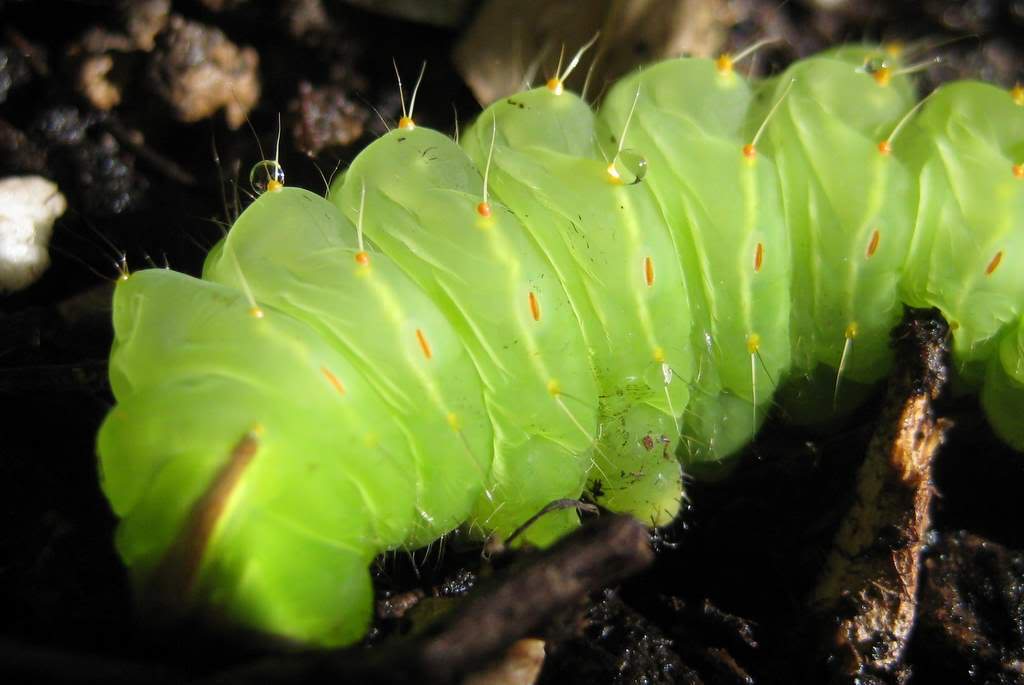A little more Lepidoptera
>> Saturday, September 11, 2010 –
butterflies,
discovery,
moths
Lepidoptera is the order of insects including moths and butterflies. Today I have a few more specimens to show you. First up is this insect that really looks like a beetle of some sort, with its long tubular body.
It's got some really interesting markings, doesn't it? This is not a beetle -- it's actually a moth! I usually think of moths as plain brown or gray, but in looking through one of my reference books (Butterflies and Moths of Missouri), there are some really unique moths around! Some are really beautiful, like this species.
This is an Ailanthus webworm moth. There are a few of them feeding on the hyacinth bean flowers up here on the deck. Here's another one:
I have to admit that I wouldn't have guessed this was a moth without a really close look. I've never seen one of these flying, or with its wings opened, but the proboscis and eyes give it away. Since the larvae feed only on the leaves of the Ailanthus tree, which I've not seen in my neighborhood, I'm surprised at how many of these guys I see around my yard. There must be one of those trees nearby -- I'll have to try and find it.
Also on the hyacinth bean flowers (I'm so glad I planted this to grow up my deck railing!) is the little butterfly that I mentioned in my recent butterfly post but couldn't get a photo of: the Red-banded hairstreak.
I didn't take any chances and snapped some photos as soon as I got close enough. Obviously this wasn't a perfect shot because the vine is partially in the way, but I didn't want to miss this chance again. This ended up being the best shot I could get. Here's the much more common gray hairstreak for comparison:
I've seen 4 or 5 of these at once up on the deck, and there may have been more -- they don't move around too much and are hard to spot amongst the hyacinth bean blooms.
Finally I'll end up this short post with a soon-to-be moth:
Yes it's a caterpillar. What I believe is a Polyphemus moth caterpillar. Here's a closer look at the head:
and here's the tail:
What was this caterpillar doing here on the soil in one of my bamboo pots? I suspect it fell out of the maple tree above this pot, or perhaps it crawled down in order to form its cocoon. I'm more likely to say it fell though, since it wasn't moving around very much. I didn't see any injuries, but it could have been internally damaged, or ill. In any case, it was still in the same place the next day, and eventually died.
Maybe I should have put it back into the maple tree, but I have a feeling that this caterpillar was going to die regardless of what I did. I hope there are more of these caterpillars in my yard, as I'd love to see one of the adult moths. I'll have to wait until the spring though, as any of these caterpillars I see now will pupate then overwinter and hatch when it warms up again. One thing I learned today is that I won't find those moths feeding at any of my flowers because the adult Polyphemus moth doesn't eat. It doesn't even have any mouthparts!
Incidentally, while researching both this caterpillar and the Ailanthus webworm moth, I found another great website with tons of photos of bugs to help with identification:
Although some of the sub-pages (such as moths) have an overwhelming number of images to look through, it's another great reference to help ID those cool bugs found in the garden!











Your caterpillar was not dying, just becoming a puppa.
I have seen them in my garden.
That is why it came down to your pot. You are right.
Mayte